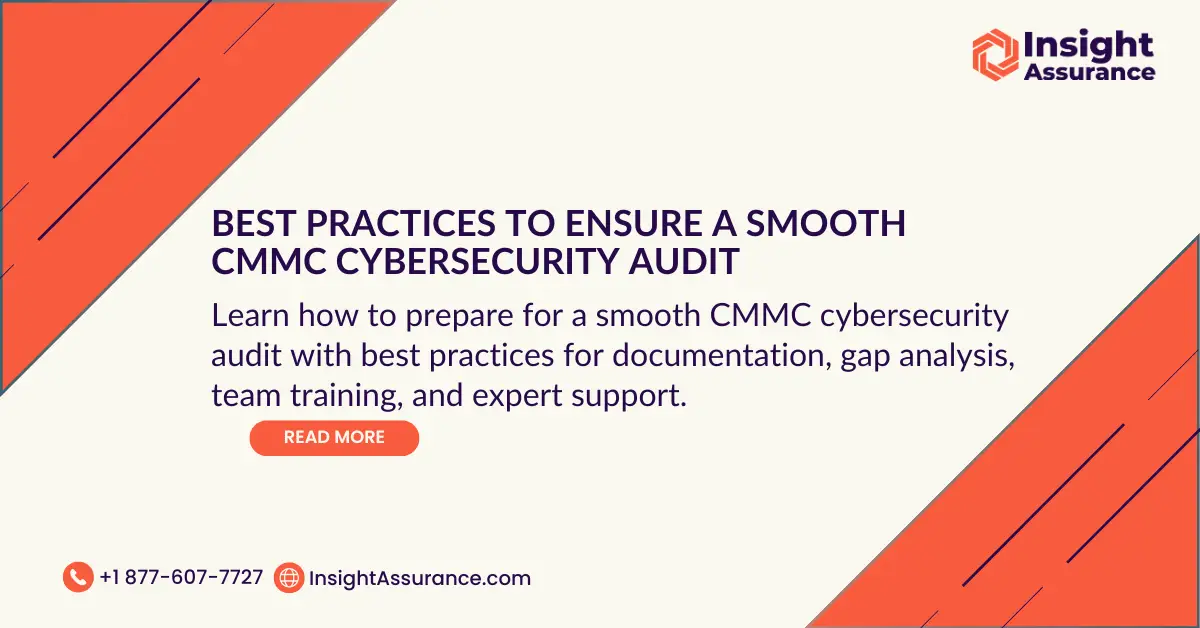Organizations in the defense industrial base (DIB) face relentless cyber threats, often from sophisticated adversaries targeting sensitive data. According to a 2022 survey, 72% of defense contractors reported experiencing at least one cyber incident within a 90-day period. These trends underscore the urgent need to safeguard Controlled Unclassified Information (CUI) and Federal Contract Information (FCI) — especially for any organization that does business with the Department of Defense (DoD).
Enter the Cybersecurity Maturity Model Certification (CMMC). CMMC sets a unified standard for implementing and assessing cybersecurity practices across the defense supply chain. A CMMC audit evaluates both policy and practice to determine how well an organization protects sensitive data. Certification confirms a contractor is qualified to handle CUI and FCI securely.
But audit readiness isn’t just about passing a test. It’s about building a cybersecurity foundation that ensures long-term contract eligibility, reduces legal and financial exposure, and fosters trust with federal stakeholders. In today’s high-stakes, fast-evolving threat environment, proactive preparation is essential for remaining competitive.
And yet, as much as 58% of the DIB report they’re not ready for CMMC compliance — and 13% haven’t taken any preparatory action at all. In this blog, we’ll break down the best practices organizations can follow to prepare for a smooth, successful CMMC audit.
1. Understand the CMMC Audit Process
Certified Third-Party Assessment Organizations (C3PAOs)
C3PAOs play a vital role in CMMC compliance. They’re authorized to conduct a formal review of an organization’s cybersecurity maturity and verify adherence to the CMMC framework, including controls designed to protect sensitive information.
In a typical CMMC assessment, these evaluators review supporting documentation, interview staff to gauge implementation maturity, and conduct tests to confirm that cybersecurity practices are truly operational. Auditors look for evidence of compliance with each CMMC requirement, focusing on areas like security controls, incident response plans, and overall risk management.
Their primary goal is to ensure that advanced persistent threats are kept at bay through well-documented and consistently implemented security protocols. By reviewing both policies and real-world practices, auditors build a comprehensive picture of how effectively an organization meets the standard of care set by the CMMC framework.
Audit Scope
The scope of each audit depends on the specific CMMC level required by the contract.
- Level 1 covers basic cyber hygiene measures, such as antivirus software and basic access controls.
- Level 2 incorporates more robust documentation and intermediate risk management processes, reflecting a higher degree of cybersecurity maturity.
- Level 3 demands an even wider scope, including advanced security controls and continual monitoring capabilities suited for more stringent defense industrial base requirements. Understanding these variations ensures that organizations can customize their approach to match the exact scope of the audit.
Aligning preparation activities with the contract’s CMMC level requirements is essential. Over-preparing for a level beyond the contractual need may be inefficient, while under-preparing can lead to potential compliance gaps and audit failures. Awareness of these distinctions helps organizations allocate resources effectively and protect federal contract information in alignment with specific contractual obligations.
2. Prepare Documentation and Evidence Early
Gathering and organizing the required documents promptly is a crucial best practice for meeting CMMC compliance requirements. Essential items include:
- A current System Security Plan that outlines controls and processes.
- System, Network, and Data Flow Diagrams to show your boundary.
- Customer Responsibility Matrix, if you have an External Service Provider.
- Asset Inventory to show all assets and asset types in scope.
By assembling these documents well in advance, organizations reduce the likelihood of last-minute confusion and demonstrate a clear commitment to maintaining a robust cybersecurity framework.
Avoid Inconsistencies Between Policy and Execution
Auditors expect to see a clear link between documented policy statements and real-world implementation. Inconsistencies — such as outdated references in policy documents or unimplemented procedures — can signal internal control gaps and put sensitive information, including controlled unclassified information and federal contract information, at risk.
A centralized, version-controlled system for evidence collection offers substantial benefits during a CMMC audit. Keeping documentation in a single, organized repository ensures that changes are tracked, and stakeholders can quickly locate the most up-to-date records. This approach also helps preserve an audit trail that demonstrates compliance maturity to the assessment team.
Keep Organized Logs
Maintaining thorough logs is another essential element of evidence collection. These logs often include access control records, incident response documentation, system audits, and user training histories. By compiling this data continuously, organizations can quickly answer auditor inquiries regarding cybersecurity incidents or verify the effectiveness of security controls.
Using robust documentation processes establishes the foundation for identifying gaps and resolving any underlying security challenges.
3. Conduct a Gap Analysis and Remediate Weaknesses
One of the most effective ways to assess audit readiness is by conducting a mock or pre-assessment using tools aligned with the CMMC model itself. These assessments help identify where current practices fall short of CMMC requirements — whether in policy, implementation, or technical controls.
Start your self assessment to calculate your SPRS score by mapping your existing security controls against the required CMMC level. Prioritize any high-risk gaps that could directly impact your ability to protect CUI or FCI, especially those that expose the organization to advanced persistent threats. By tackling these issues early, you can mitigate risk while demonstrating a commitment to continuous improvement.
Addressing Compliance Gaps
Remediation often involves updating documentation, refining procedures, and implementing new security measures. For example, adding multi-factor authentication or enforcing stricter access controls are quick wins that can significantly strengthen your security posture. These improvements also signal to auditors that the organization is evolving toward a more mature and resilient cybersecurity environment.
As part of your preparation, conduct internal reviews to test whether new controls are functioning as intended. These exercises can uncover overlooked weaknesses and give teams a chance to fine-tune processes before the official audit begins. They also build confidence across departments — especially when staff are involved in simulations that mirror real auditor interactions.
Ultimately, a thorough self assessment followed by targeted remediation is the backbone of a successful CMMC audit. It shows you’re not just compliant on paper, but operationally ready to secure sensitive defense data.
4. Train and Prepare Internal Teams
CMMC compliance isn’t solely the responsibility of your IT department — it requires organization-wide awareness and alignment. Every team, from operations to HR to finance, plays a role in maintaining the security of sensitive data. Ensuring staff understand their responsibilities is critical for both day-to-day protection and audit success.
Start by providing role-based training that covers core topics like data handling, access controls, and incident response. Employees should know how to identify threats like phishing attempts, follow escalation procedures, and securely interact with CUI. The more confidently your team can execute these practices, the more resilient your organization becomes.
It’s also important to prepare staff for the human side of the audit. Auditors may conduct interviews to assess whether employees understand and follow documented policies. Hosting mock interviews or tabletop exercises can help teams feel prepared and comfortable discussing their responsibilities, reducing the risk of inconsistencies or miscommunication during the real assessment.
Fostering a culture of compliance makes a measurable difference. That means securing buy-in from leadership, reinforcing policies through regular communication, and making cybersecurity an ongoing conversation, not just a one-time initiative. When employees are engaged and informed, your audit readiness improves across the board.
In short, well-trained teams don’t just support CMMC compliance — they prove that your organization lives it.
5. Work with CMMC Experts to Streamline the Process
Even with the best internal efforts, preparing for a CMMC audit can be complex and resource-intensive. That’s why many contractors turn to external experts for guidance. These specialists help ensure nothing critical is overlooked and that your compliance strategy is both thorough and efficient.
CMMC consultants can assist with everything from policy refinement and technical remediation to staff training and mock audits. Their deep understanding of the CMMC framework allows them to spot gaps, interpret evolving requirements, and prioritize improvements based on risk and impact. With their support, organizations avoid wasted effort and focus on the areas that matter most to auditors.
Engaging experts early in the process is key. It can prevent costly delays, reduce scope creep, and accelerate remediation by giving your team a clear roadmap to follow. External partners also provide a valuable third-party perspective, helping validate internal assumptions and improve your overall readiness posture.
Take Insight Assurance, for example. We offer targeted audit readiness and cybersecurity consulting tailored to defense contractors of all sizes. Our team helps organizations prepare confidently for CMMC certification — not just to pass the audit, but to build long-term resilience and contract competitiveness.
Ready for Your Next CMMC Audit?
Achieving CMMC certification isn’t just a requirement — it’s a strategic advantage. For defense contractors, it signals to the DoD and other stakeholders that your organization takes cybersecurity seriously and is committed to protecting sensitive information across the supply chain.
But CMMC readiness goes beyond checking boxes. It’s about building a sustainable security posture that reduces risk, strengthens operational resilience, and earns long-term trust. With evolving threats and tightening compliance expectations, organizations that invest in maturity today will be better positioned for tomorrow’s opportunities.
Whether you’re just starting your CMMC journey or finalizing your audit preparation, Insight Assurance can help. Our team specializes in audit readiness and assessment services tailored to the defense industrial base. We’ll guide you through the process so you can approach certification with clarity and confidence.
Contact us today to streamline your path to CMMC compliance and strengthen your competitive standing in the DIB ecosystem.


